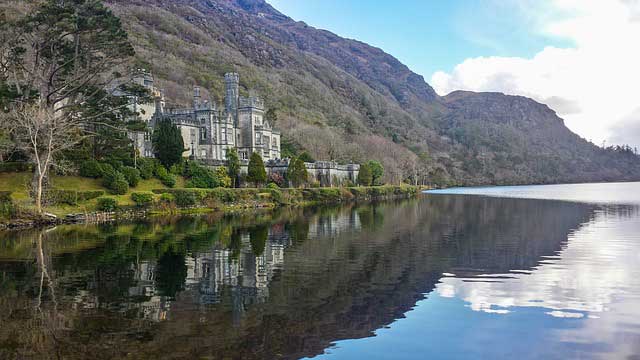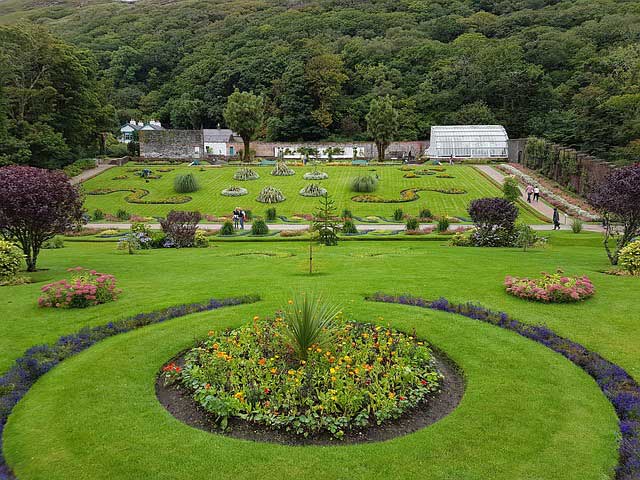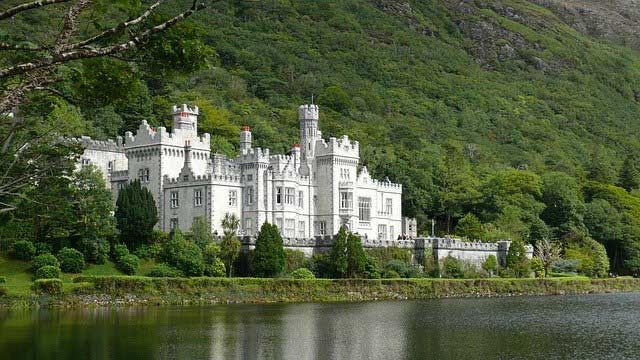Kylemore Abbey is magically located in the enchanting area of Connemara in the Western County of Galway within the ancient mystical province of Connaught.
Kylemore Abbey is nestled peacefully on the banks of Kylemore Lough, surrounded by the beautiful rolling mountains of Connemara. The tales of ancient legends and myths seem to come alive in this wondrous area of Ireland.
Where the ghosts of our past seem to whisper from every rock and the rolling luscious green landscape.
The magical Abbey seems to have been designed to perfectly blend with this dramatic landscape. It is like something from a fairytale engulfed in our stunning landscape and deep rooted in out history.
This is an architectural masterpiece whose foundation and future is a part of this landscape and though times of extreme tragedy and change has adapted and overcome adversity.
This is a building that has had to adapt with the changing world to survive and has done so with the most wonderful outcomes.
The History of Kylemore Abbey.

This enchanting and beautiful Castle was constructed in 1868 by Mitchell Henry as an expression of love and devotion for his wife and family.
As newlyweds the couple had honeymooned in Ireland and fell in love with epic beusty and enchantments of Connemara and its wonderful people.
At that time Kylemore was just a small lodge. Mitchell was a very successful eye surgeon and had a practice in the internationally famous Harley Street, London.
Mitchell was left a substantial inheritance when his father died and he becomes one of the richest men in England. With his vast inheritance he decided to buy his beloved Kylemore Lodge and turn it into the fairytale Castle we see today.
The architect of his grand design was James Franklin Fuller and the skilled engineer employed to bring this dream to life was Robert Kylemore.
Together they made the dream that was to become Kylemore Castle a reality.
The opulent castle comprised of 33 bedrooms, 4 bathrooms, 4 sitting rooms, a ballroom, and library, smoking room and staff quarters.
During the construction of this vast residence there was a shock local people, as this was the first time dynamite blasting was to be heard in the area.
The castle sits nestled into the side of the magical mountain region of Connemara and overlooks the mystical and ancient Lough Pollaacapull.
Margaret completely loved life in her castle and thrived on making this Castle one of the most dramatic buildings in Ireland. She had wonderful taste and this was seen in the castle.
She employed vast numbers of skilled Italian and Irish craftsmen to create the magnificent interiors. The family loved to travel and on a trip to Egypt Margaret became fatally ill and died at the age of 45.
Margaret was embalmed in Egypt and was brought home and buried in her beloved Kylemore. Upon the death of his beloved and adored wife Henry was inconsolable, surrounded by memories in Kylemore of his wife he decided to become more involved in Irish politics. He went on to become a member of Issac Butts Home Rule Party.
As a monument to his wife Henry decided to built the Neo-Gothic Church in the grounds of Kylemore to house the remains of his beloved Margaret, Henry would be laid to rest in this stuffing church with his beloved wife when he passed away at the age of 84.
Henry a man with a vision of the future and he working towards making Kylemore a working and profitable business. He began reclaiming the bog land of the area and turned this bog land into agricultural arable land.
The people of this area were still recovering from the ravages of the Great Famine and he provided work for those that remained and a school to educate the children of this deprived area, giving them a chance at a better future.
He built the beautiful Victorian walled gardens that provided fruit and vegetables.
The many Guests that visited the Castle were treated to lavish parties and were served the local produce such as salmon and game. The castle and estate was sold in 1903 Kylemore Abbey was purchased by the The Duke of Manchester
They made many changes to this magnificent castle tragically including the removal of Italian and Connemara marble. The castle was used to showcase their opulent life style.
The Duke had been bankrupt but his marriage to Helena Zimmerman changed his fortunes, as she was an heiress. Helena’s father passed away in 1914 and the Duke and Duchess decided to live Kylemore. Later the couple divorced in 193.
Helena went on to marry the 10th Earl of Kintore in Scotland.
Kylemore Abbey and the Benedictine Order.

The Benedictine Nuns arrived in Kylemore in 1920.The Benedictine order originated in Brussels and was founded by Lady Mary Percy.
The sisters from Ypres Abbey in Belgium catered for many students from Europe’s wealthiest families.
The sisters left Ypres and moved to Dublin in 1688 but moved back to Ypres after King James lost at the nuns eventually left Ypres and moved to Wexford before finally moving to Kylemore.
The sisters opened up a boarding school for girls. The school was a girl’s only. The Benedictine sisters were renowned for their excellent standard of education.
Students from all over the world were educated at Kylemore Abbey. The school was considered to be for the elite and wealthy and had a very prestigious reputation. Unfortunately due to rising of costs and lack of teaching staff the school was closed in 2010.
Kylemore Abbey has now diversified and is a thriving centre of culture and excellence.
Visiting Kylemore Abbey
The Victorian Walled Gardens had at one time in the long life of Kylemore Abbey comprised of 21 heated glass houses and employed 40 gardeners. Over the years the garden became overgrown.
The Benedictine nuns began to restore the garden in 1995 and in 2001 they were opened to the public. The garden is about 6 acres and comprises of formal flower garden glass houses, vegetable garden, fruit trees and herb garden and a beautiful gardeners cottage
Today Kylemore Abbey has seen a new era dawn on its historic stone. Visiting Kylemore Abbey is a cultural and educational experience with its wonderful tours and historically fascinating past on display.
Kylemore Abbey is home to a wonderful restaurant that offers outstanding home cooked traditional food.
The traditional Tea House located beside the walled gardens is a relaxing and indulgent experience.
They offer Light lunches. Herbal teas are made form the herb garden. If weather is good there is outdoor tables including a wonderful children’s area.
The tour of the Victorian Walled garden lasts about 30 minutes.
There is also a guided hiking tour of the mountains regions surrounding Kylemore Abbey.
A day at Kylemore Abbey would not be complete without a visit to the wonderfully stocked gift shop.
The staff are professional and helpful and arrangement shipping for their huge selection of beautiful crafts. Kylemore Abbey Pottery is the beautiful world famous ceramics that are designed by Debbie Watkins.
Inspiration for this amazing pottery comes from the wild Fuchia flower which is found locally and known in Irish as Deora De. Which means the Tear of God.
Every piece is handcrafted in the studio at Kylemore Abbey. During her time as First Lady of the United States, Michelle Obama received a hamper of Kylemore Abbey Pottery on St Patrick’s Day as a gift from the Irish people.
In the gift shop you will also find a selection of delicious and luxurious hand made chocolates and artisan foods. As well as locally made and sourced Irish beauty products.
Next door to the Gift Shop is the Soap Room.
This is where the sisters who still live in the Abbey make beautiful soaps, candles and skincare products, that are made from essential oils. All these wonderful products can also be purchased online.

